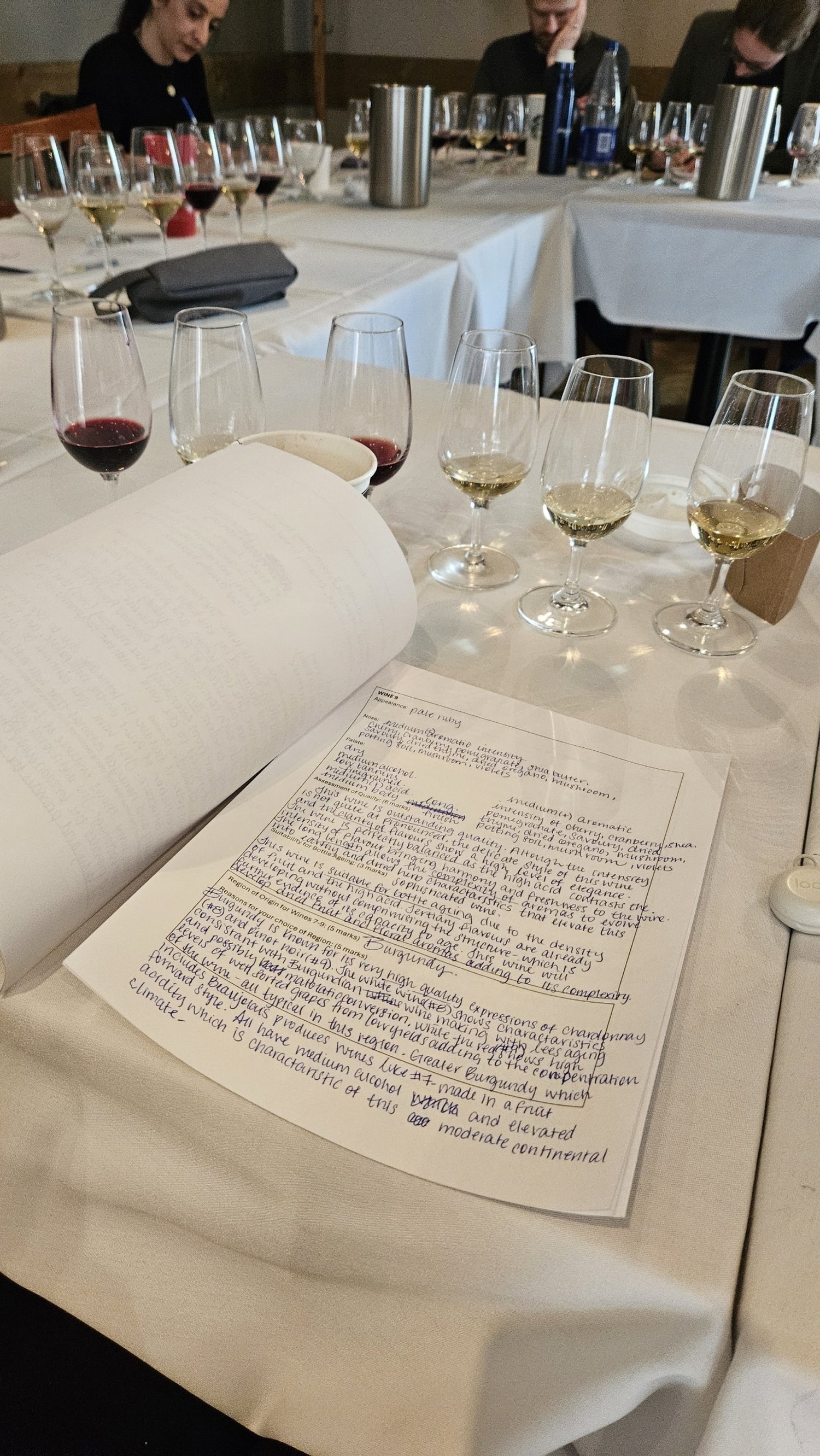How to Pass the WSET Diploma Tasting Exams + 2 free resources.
Written by Randi Klassen (@randithesomm)
When you're tackling the WSET Diploma, it's easy to feel overwhelmed—especially when it comes to the tasting exams (D3, D4, D5). Whether you’re swirling a Bordeaux or staring blankly at a glass of Crémant, the pressure to assess and articulate wine like a pro is very real.
I was told in my first week of diploma tastings that I “possibly had the worst palate in the class”. After completing all my units and passing the tasting exams with Merits or Distinctions (THANK YOU VERY MUCH), I’m here to tell you: your palate is a muscle, and like any other muscle, it gets better with training—and the right technique.
Here are the steps to creating a functional and efficient wine tasting group.
Calibrate with your people
Taste in exam format
Readdress common faults quickly
Track ‘the Spec’
Master the Quality Assessment
Mock Exam
1. Calibrate Your Palate with Your People
Find your people. Your tasting group will make or break this journey. Tasting together helps you collectively refine your ability to call alcohol, acid, tannin, sweetness, and body levels accurately.
In our group, we slowly built consensus on these core calls. At first, our notes were all over the place—but over time, we converged. Our collective calibration made our conversations deeper, more confident, and more exam-ready. Eventually, we weren’t just calling wine characteristics accurately across the board—we were talking viticulture, winemaking choices, and commercial positioning. These conversations made our theory writing sharper, too.
2. Taste in Exam Format from Day One
If you want to pass the WSET Diploma tasting exams, your best friend is structure. Our group always tasted in exam format—flights of three wines, themed by variety, country, or region.
We mirrored the structure of D3’s four flights:
1. A common grape variety
2. A specific country
3. A key wine region
4. A wildcard set (a curveball to keep you humble)
And yes—we always tasted blind. Leaving 1-2 people to pick out the wines for each tasting session. Label bias is sneaky. You’ll learn this the day you call a Classed Growth Pauillac “acceptable quality.” Trust me, I’ve been there.
We also time-boxed each wine to 8 minutes per dry note, leaving us 7 minutes in the real exam to write, solve the puzzle, and tackle bonus questions.
3. Readdress Common Faults and Misconceptions in Sighted Tastings
The only time that we would taste wines sighted, was when we would identify a mistake that was made commonly. For our group, one example was regular mix up’s between dry rieslings and chenin blanc. To combat this issue head on, we would taste them side by side, back and forth and discuss how to tweeze out the differences in the wines.
4. Get Organized with a Spec Tracking Document
Additionally, we created a shared document that tracked every wine on the specification list: which wines we’d tasted, how often, and which ones we still needed to hit. This helped us stay balanced in our exposure and avoid showing up to the exam having never tasted, say, Tokaji or Franciacorta.
And yes, you can download that very same tracker right here:
Google Spreadsheets Version - open link and then select file —> make a copy
5. Master the Art of Quality Assessment
Next up: BLIC (Balance, Length, Intensity, Complexity).
It's not just an acronym—it’s your ticket to marks full marks in the Quality Assessment section (which makes up about 20% of available marks). The most common line in the examiners reports is “it is not enough to say the wine is balanced, you must explain why it is balanced”
We practiced articulating what was balanced about each wine and how to defend our judgments.
Some of us even preferred BLICE, adding Expression/Execution to the mix—asking: does this wine speak to its place and grape? Does it show a typicity to the classic wines of the region? Did the winemaker show expertise in the amount of oak use, or the amount of lees stirring imparted on the wine to bring extra texture or complexity?
Once we nailed quality, we moved on to ageing potential—because suitable for ageing isn’t just a feeling. It’s a defendable argument.
6. Run a Mock Exam
About two weeks before the real thing, we ran a full mock exam. We invited a past Diploma graduate to select and pour the wines, printed off exam-style tasting sheets, and locked ourselves in a quiet room with nothing but glassware and willpower.
Exam 1 (common variety and common country) started promptly at 10 am and Exam 2 (common region and mixed bag) started at 1 pm to mimic exam timings.
After the tasting, we peer-marked using our group’s palate consensus and WSET’s quality descriptors. This step was a huge confidence booster—it showed us exactly where we were strong and where we needed a last-minute review.
Download my pdf for D3 Mock Exam Wine Tasting Template:
Bonus: Other Tricks of the Trade
Invest in a Coravin to make those expensive bottles go further
Head out to wine fairs as many times as possible
Bulk up on your own faults for personal tastings (mine was the Bordeaux family - so my pantry was full of Cabernet Sauvignon, Cabernet Franc, Merlot, Malbec, and Carmenere for direct and frequent comparisons)
Final Thoughts
Passing the WSET Diploma tasting exams isn’t about being born with a magical palate—it’s about building one. Taste often, taste blind, taste together. Be methodical, be honest, be curious. And when in doubt, book a mock exam and let it show you what you’re made of.
You’ve got this.
Cheers,
Randi












